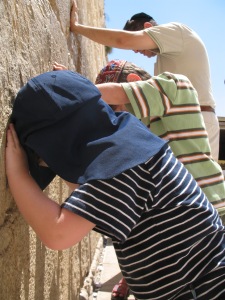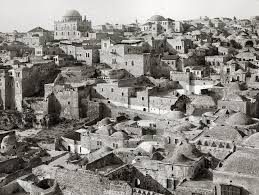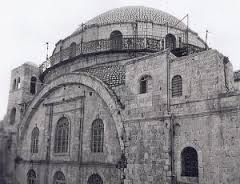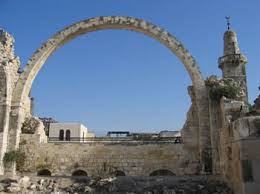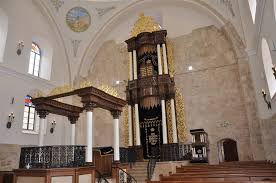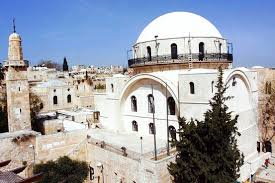A Review of Five Sacred Sites
The United Nations is inconsistent regarding its position on the “character”, “access” and “rights” of holy sites in the Holy Land across the Green Line.
In 2010, UNESCO published a paper highly critical of Israel regarding its treatment of two holy places in Judea and Samaria/the West Bank: the Tomb of the Patriarchs in Hebron and the Tomb of Rachel in Bethlehem. The statements were a complete inversion of the truth:
- “Since Israel’s occupation, the Israeli Government has attempted to highlight the Jewish character of archaeological and heritage sites in the occupied Palestinian territory, while erasing or neglecting the universal character of these heritage sites and denying access to all people of faith.”
- “As part of the illegal settlement enterprise, the Israeli authorities also exploit Palestinian heritage sites for financial and political gains. Under the Netanyahu administration, Israel has publicly begun to use these sacred and universal sites to provoke unnecessary religious conflict by promoting control and access on the exclusive basis of one faith while denying the rights and views of other faiths.” UNESCO PARIS, 19 March 2010
TOMB OF THE PATRIARCHS (HEBRON)
As a point of reference (as detailed in the FirstOneThrough article) almost all of the Jewish forefathers and foremothers are buried at the tomb. As such, it is the second holiest site in Judaism (after the Temple Mount in Jerusalem). Biblical characters Ishmael and Esav (forefathers of the Arabs) are not attributed to this burial site.
The tomb was a destination for Jewish pilgrims since its purchase by Abraham 3700 years ago, and for the following 2900 years. Roughly 800 years ago, Muslims took over Hebron and converted the tomb into a mosque. The Muslims forbade Jews from entering the area, and even approaching beyond the seventh step of the platform. That changed when the Israelis took over the site after the Jordanians and Palestinians attacked Israel and lost the West Bank in 1967.
- It was the Muslims that “erased and neglected the universal character” of the site
- It was the Muslims that ”denied access to all people of faith”
- And It was the Jews that opened the Tomb for both Muslim and Jewish prayer
THE TOMB OF RACHEL (BETHLEHEM)
As the burial site of one of Judaism’s foremothers, the tomb of Rachel is considered the third holiest site in Judaism (similar to Al Aqsa Mosque in Jerusalem for Muslims).
The Crusaders built a small covering for the gravesite in the 1200s and around 1517, the Ottomans denied non-Muslim prayer when they took over control of Bethlehem. In 1615, Mohammed, Pasha of Jerusalem transferred exclusive use of the tomb to Jews, but the site fell into disrepair. In 1841, Jewish philanthropist and traveler, Sir Moses Montefiore was given the keys to the tomb and permission to build a larger structure for pilgrims.
Over the years, the area around the tomb became more densely populated. As Bethlehem was only 5 kilometers south of Jerusalem, the growth of both cities created a greater metropolitan area. The United Nations 1947 partition plan recommended that this Greater Jerusalem / Greater Bethlehem area become a single “Holy Basin” under international control, being neither Israeli nor Palestinian. While accepted by the Israelis, the Palestinians rejected the proposal.
In 1948, five Arab armies attacked Israel and Jordan illegally annexed Judea and Samaria, including Bethlehem. In 1954, the Jordanians gave Palestinian Arabs citizenship but specifically excluded citizenship for any Jews. After 333 years, the third holiest site of Judaism became off-limits to all Israelis.
Israelis took control of the area after the defeat of the Jordanians (and Palestinians) in 1967, and opened the tomb to Jewish worship once again.
In 1995, as part of the Oslo Agreements, Israel handed over control of half of the “Holy Basin” – Bethlehem – to the Palestinian Authority, under the condition that Jews be able to freely access and pray at the tomb. With that handover, the Tomb of Rachel fell under Palestinian Authority.
During the Second Intifada in 2002, with almost daily killings of Jews by Arabs, the Israeli government built a security barrier through parts of the West Bank. In 2005, a wall was built around the Tomb of Rachel to protect it from Arab assault.
- The site is not even considered sacred to Islam, yet for almost 100 years, Muslims denied the rights of Jews to pray at the tomb
- It was Ottomans of centuries ago who gave the Tomb of Rachel back to Jews
- Modern Jordanians and Palestinians denied citizenship and access to the tomb for Jews
- It was Israel that reopened access and rights for Jews at the tomb
- It was Israel that agreed to give control of the “Holy Basin” to the U.N. in 1947
- It was Israel that agreed to compromise and divided half of the “Holy Basin”, handing control of the city to the Palestinians in 1995
There are other examples of the United Nations condemning Israel for opening up access to holy sites, while ignoring the denial of access and destruction that Arabs caused to holy places.
JOSEPH’S TOMB (NABLUS/SHECHEM)
The Tomb of Joseph, the biblical son of Jacob and Rachel, is found in Nablus (Shechem). After the 1967 war, Israel gained access to the site once more and built a small seminary nearby in the 1980s.
Israel handed control of Nablus to the Palestinians in 1995, but retained control of Joseph’s Tomb. However, during the Intifada in October 2000, Palestinians ransacked the tomb and killed an Israeli soldier and Rabbi Hillel Lieberman who came to protect the site. His body was found in a ditch riddled with bullets.
Israel agreed to give temporary control of the tomb to the Palestinians to quiet the situation and to allow the Palestinians to repair the tomb. However, the site was set on fire and further ransacked. Later, the Associated Press reported that “the dome of the tomb was painted green and bulldozers were seen clearing the surrounding area,” as the Palestinian Arabs sought to transform the biblical Joseph’s resting place into a Moslem holy site.
Israeli president Shimon Peres remarked that the “Palestinians made a terrible mistake in Joseph’s Tomb. They pulled the rug out from under their feet regarding their demand for control of the holy places, by showing that they don’t know how to preserve and respect them.”
- It was Arabs that vandalized a Jewish site
- It was Palestinians that sought to change the character of Joseph’s tomb
- It was Israel that handed temporary control of the site to Palestinians to try to quell violence
What was the United Nations response to ransacking of a Jewish holy place? Of attempting to “change the character” of the Jewish site? Silence. No comment nor condemnation.
What was the UN response to a visit to the Temple Mount by Israeli Prime Minister Ariel Sharon two weeks earlier? Condemnation.
- “Deplores the provocation carried out at Al-Haram Al-Sharif in Jerusalem on 28 September 2000”
The UN Secretary General condemned the Israeli prime minister for exercising his “right” for “accessing” Judaism’s holiest site during normal visiting hours.
THE HURVA SYNAGOGUE (JERUSALEM)
Jews began construction of a significant synagogue in the Old City of Jerusalem in 1694 called the Hurva Synagogue which was destroyed by Muslims in 1721. Groundbreaking for rebuilding the shul happened in 1855, and it was rededicated on completion in 1864.
In 1949, the Jordanian army attacked the Jews in Jerusalem and blew up the Hurva Synagogue and 57 other synagogues in the Old City. They expelled the 2000 Jewish residents and forbade them from returning.
After the Jordanians (and Palestinians) attacked Israel again in 1967, Jews retook the Old City but did not seek to rebuild the Hurva right away. In 2010, Israel finally rebuilt and reopened the synagogue before the Passover holiday. There was condemnation from around the world.
Fatah official Khatem Abd al-Khader called the reopening a “provocation” and warned that Israel “was playing with fire”. Khaled Meshaal of Hamas said the opening was a “declaration of war” and “a falsification of history and Jerusalem’s religious and historic monuments.” The Jordanian government (that intentionally blew up the synagogue) “categorically rejects the rededication of Hurva Synagogue.”
These reactions were about a synagogue that had absolutely no connection to Islam.
- Arabs destroyed the synagogue
- The Jordanian and Palestinian Arabs denied access to the Old City and site
- Palestinians threatened violence over rebuilding a synagogue they destroyed
- Palestinian leadership incited a riot by falsely stating that Jews were attempting to destroy the Al Aqsa mosque
How did the United Nations respond to the reopening of the Hurva Synagogue?
- Ban Ki Moon March 2010: “I have spoken out and have been diplomatically active whenever other provocations have taken place – including the decisions on holy sites in Hebron and Bethlehem, actions in places like Silwan and Sheikh Jarrah and tensions surrounding the Al-Aqsa Mosque.”
THE TEMPLE MOUNT (JERUSALEM)
The first Jewish Temple was built by King Solomon around the year 954BCE. At that time, there was no large platform that we know of today. That Temple was destroyed around the year 586BCE. A second Temple was built around 515BCE and destroyed in 70CE.
Before the Second Temple was destroyed, King Herod did major renovations in Jerusalem, including extending and building a large platform on which the Second Temple sat (from 19BCE until 63CE). Today’s “Western Wall” or “Wailing Wall” is the western retaining wall of that platform extension. It is also the area where Muslims built the Al Aqsa mosque in 705CE. That original mosque was destroyed several times, and the silver domed mosque of Al Aqsa that sits on the southern-most edge of the Temple Mount that we see today, was completed in 1033CE.
Christian crusaders came to Jerusalem in 1099, slaughtered the Jewish and Muslim inhabitants and took over the Temple Mount. Crusaders and Muslims fought over control of Jerusalem on-and-off through the year 1260, with the Muslims ultimately prevailing.
With the Muslim victory, Jews began to move back to Jerusalem, and the first new permanent synagogue in Jerusalem was set up by Nachmanides (the Ramban) in 1267. Over the next centuries, several noted rabbis stated that it was the custom of Jews in Jerusalem to ascend the Temple Mount and pray there, including Rabbi Menachem Meiri (1249-1316) and Rabbi David ben Shlomo Ibn Zimra, (known as the Radbaz, 1479–1573), the Chief Rabbi of Jerusalem.
However, in 1550, Ottoman leader Suleiman I set aside the Western Wall area as a designated area for the Jews to pray. It would appear that from this date until 1949, non-Muslims could have access but were effectively barred from praying on the Temple Mount.
After the defeat of the Ottoman Empire in 1918, the local Arab population became very anxious about future control of the land, especially in light of the 1920 San Remo Conference and the 1922 British Mandate which specifically described ensuring a Jewish homeland in Palestine. Every “normal” action of prayer at the Western Wall was viewed by the Arabs as a change to the status quo, and as such, a “provocation” in which “Zionists” were taking over.
- In 1925, a new prohibition against bringing chairs or benches to the Western Wall (in response to bringing chairs for the elderly and infirm)
- In 1928, a new prohibition of erecting a screen (mechitza) between men and women for prayer (in response to putting one up on Yom Kippur) at the Western Wall
In 1929, Arabs rioted at the Western Wall, first burning prayer books and later calling for Jihad as they rampaged through the city killing dozens of Jews. They felt that Islamic authority at the Western Wall was being called into question as an initial step to the takeover of the Temple Mount.
In 1948, the Arab armies of Egypt, Lebanon, Syria, Jordan, and Iraq attacked Israel. At war’s end the following year, the city of Jerusalem became divided with the Jordanians occupying the Old City including the Temple Mount. After the Jordanians evicted all of the Jewish inhabitants, they banned any Jew from coming into the Old City and visiting the Western Wall and the Temple Mount.
During that war, in December 1948, the United Nations Resolution 194 again called for the “Holy Basin” to be under international jurisdiction and that all holy sites should be given free access, with a carve-out for historical practices of discrimination:
- “Resolves that the Holy Places – including Nazareth – religious buildings and sites in Palestine should be protected and free access to them assured, in accordance with existing rights and historical practice”
- Resolves that, in view of its association with three world religions, the Jerusalem area, including the present municipality of Jerusalem plus the surrounding villages and towns, the most eastern of which shall be Abu Dis; the most southern, Bethlehem; the most western, Ein Karim (including also the built-up area of Motsa); and the most northern, Shu’fat, should be accorded special and separate treatment from the rest of Palestine and should be placed under effective United Nations control”
In 1967, in response to a preemptive Israeli attack on Egypt and Syria, Jordanian (and Palestinian) forces attacked Israel. The Israelis took the Old City of Jerusalem including the Temple Mount, but handed administrative control of the Mount to the Jordanian Waqf. The plaza in front of the Western Wall was expanded to enable thousands of Jews to pray at the site. Israel enshrined the protections of Holy Places in its Basic Laws in June 1967:
- “The Holy Places shall be protected from desecration and any other violation and from anything likely to violate the freedom of access of the members of the different religions to the places sacred to them or their feelings with regard to those places.”
- “Whosoever does anything likely to violate the freedom of access of the members of the different religions to the places sacred to them or their feelings with regard to those places shall be liable to imprisonment for a term of five years.”
Israel opened up the Temple Mount for non-Muslim visitors during specified visiting hours. However, non-Muslims were still prohibited from praying on the Mount according to the wishes of the Jordanian Waqf.
Many Israelis were not happy with maintaining the discriminatory policy and lobbied the Israeli government to make changes. One such activist, Yehuda Glick, was shot repeatedly by two Palestinians for those efforts in October 2014.
In response to the shooting of Glick and the killing of the two Palestinian Arabs who shot him, the United Nations Secretary General Ban Ki Moon discussed his displeasure with Israelis on the Temple Mount:
- “As you mentioned this holy site in Jerusalem and as I also said this morning, I am deeply concerned by repeated provocations at the holy sites in Jerusalem. These only inflame tensions and must stop.”
- On November 24, 2014: “Incitement and provocative acts related to the holy sites are fanning the flames of conflict far beyond the holy city.”
While the United Nations claims to care about keeping the universal access and rights to people of all faiths, it condemns the only party – Israel – which practices those values and even enshrines those values into the Basic Laws of the country. Further, the U.N. ignores the actions of the Arabs which deliberately have erased the Jewish character and rights of Jews to pray at their holiest sites.
For 800 years, from the Arab conquest of Jerusalem and the introduction of Islam to the Holy Land until 1550, Islamic and Jewish prayer both occurred on the Temple Mount.
It is not only time for there to be open access and rights for Jews, but it is time for the United Nations to acknowledge the party that provides access and rights, and the parties that do not.
Sources:
UNESCO claim that Israel is Judaizing the Cave of the Patriarchs and The Tomb of Rachel (2010). http://unispal.un.org/UNISPAL.NSF/0/8F8CBDCA74D7D20385257721007157CF
FirstOneThrough article on Tomb of Patriarchs: https://firstonethrough.wordpress.com/2014/11/17/joint-prayer-the-cave-of-the-patriarchs-and-the-temple-mount/
History of Rachel’s Tomb: http://www.rachelstomb.org/capsulehistory.html
Bethlehem changing hands: http://www.jpost.com/Features/In-Thespotlight/This-Week-In-History-Bethlehem-changes-hands
Bethlehem history: http://www.zionism-israel.com/dic/Rachels_Tomb.htm
Article on Tomb of Rachel: http://www.timesofisrael.com/on-obamas-path-to-bethlehem-a-harshly-fortified-shrine/
Jordanian Nationality Law barring citizenship to Jews (Article 3): “The following shall be deemed to be Jordanian nationals:… Any person who, not being Jewish,…” http://www.refworld.org/docid/3ae6b4ea13.html
Jordan (and Palestinians attack Israel in 1967):
Tomb of Joseph: http://www.jewishvirtuallibrary.org/jsource/Judaism/joetomb.html
Hillel Lieberman: http://www.shechem.org/elon-moreh/enghillel.html
Ascending to the Temple Mount: http://www.google.com/url?sa=t&rct=j&q=&esrc=s&source=web&cd=3&ved=0CC4QFjAC&url=http%3A%2F%2Fwww.hakirah.org%2FVol%252016%2520Loewenberg.pdf&ei=Ldd1VO_lIO_HsQSxxILoAg&usg=AFQjCNFI6ujLjX2fEw6kPd6QNgTqQoN57A&sig2=JhXKJuu8BPvY_Oint80UKA
1929 riots: http://www.google.com/url?sa=t&rct=j&q=&esrc=s&source=web&cd=8&ved=0CFMQFjAH&url=http%3A%2F%2Fisites.harvard.edu%2Ffs%2Fdocs%2Ficb.topic1232564.files%2FSela_1929.pdf&ei=ud11VL2XLKaMsQS34ILIBw&usg=AFQjCNFrq28tbKf1Uns0HD-GAFYPBo7vQg&sig2=aUGriieF5AxIpKxwTtbApQ
UN Resolution 194: http://unispal.un.org/UNISPAL.NSF/0/C758572B78D1CD0085256BCF0077E51A
Israel Law on Protection of Holy Places (1967): http://www.bu.edu/mzank/Jerusalem/tx/lawofholyplaces1967.htm
Yehuda Glick shooting: http://www.jpost.com/Arab-Israeli-Conflict/Report-Suspect-in-right-wing-activist-Yehuda-Glicks-shooting-killed-by-police-380238
UN Security Council Resolution 1322 condemning Sharon visit to the Temple Mount: http://unispal.un.org/UNISPAL.NSF/0/22F8A95E5C0579AF052569720007921E
UNESCO 2013: http://www.haaretz.com/blogs/diplomania/israel-thwarts-unesco-resolution-condemning-its-temple-mount-activities.premium-1.470609
Ban Ki Moon on Temple Mount: http://www.theguardian.com/world/2014/oct/13/un-general-secretary-ban-ki-moon-criticises-israel-settlement-building
http://www.un.org/apps/news/infocus/sgspeeches/statments_full.asp?statID=2444#.VHR3U_8tCUk
http://www.un.org/apps/news/infocus/sgspeeches/statments_full.asp?statID=767#.VHR4X_8tCUk
